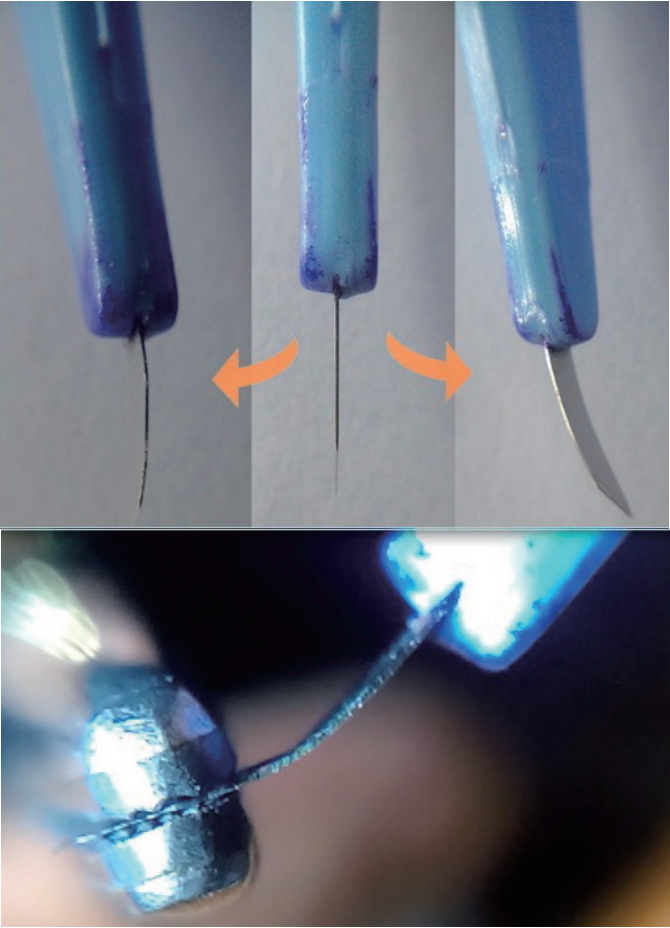INTRODUCTION
Restoration of the normal temporal area is an essential part of modern hair restoration, but doing so is technically very difficult. That is why, in the past, hair restoration surgeons were reluctant to restore this area [1]. Various systems for classification of temporal point recession are available [2,3]. The male temporal area normally consists of a concave lower border whose superior margin forms the temporal point [4]. A different degree of recession may be noted on the right and left sides, which further stresses the need to restore the temporal peaks to balance the face [5]. The recreation of the anterior hairline without addressing the area of the temporal peaks produces the unnatural effect of wearing a hairpiece [4]. Although the temporal hair is not dense, the angles of the exiting hair are very acute (10┬░ or less), which creates problems for the restoration surgeon. There is also a change in the hair direction in the upper and lower parts of the temporal peaks.
The author hereby presents his technique for addressing the temporal areas.
ANATOMICAL FACTORS
The author has noted that the direction of hair in the temporal area is different on the right and left side. This may be related to the location of the scalp whorl, but no study to date is available to verify this clinical observation.
PROPOSED ZONES RECONSTRUCTION
The author has divided the temporal peaks area into three zones (I, II and III). Zone I includes the first 1 cm of the area to be reconstructed. It has an upper limb and a lower limb. Zone II is 1 to 2 cm in width and follows zone I (Fig. 1). Zone III is triangular in shape and lies next to zone II.
Only single-hair containing follicular units (FUs) with fine hairs should be used in zone I. The density may vary from 10 to 15 per cm2. In zone II, single-hair containing FUs should be used, but the density should be slightly higher than in zone I (i.e., 15 to 20 per cm2). In zone III, 1- or 2-hair FUs should be used to match the density of the pre-existing temporal hair (25 to 30 per cm2). Only single-hair FUs should be used in zone I and II so that in the worst case scenario, if these hairs fall out due to aging, the 2-hair FUs would be hidden, as even one of the 2-hair FUs may create an unnatural look (Fig. 1).
DISCUSSION
Hair restoration surgeons have various techniques they have personally developed to recreate the temporal peaks. For example, the use of hair from the nape of the neck or the use of a laser, which can alter the characteristics of the hair, both give the area a softer look [6]. The most important point in temporal hair recreation is the angle of the hair shaft exit. Every effort must be made to keep the angles as acute as possible (10┬░ or less). The author uses super-inflation with saline in the superficial skin layers. The thumb is used to press the skin down like a fulcrum of lever. This maneuver lifts the distal part of the skin where the blade enters the skin to make the slits. In addition, the blade is also turned slightly, in such a way that the concave side of the blade faces away from the nose of the patient while making slits (Fig. 2). This is achieved by holding the blade in the needle holder and gently twisting the blade, resulting in a slight curve in the blade. Care is taken not to make the curve very acute, as it may break the blade during twisting or during the process of slit creation. This maneuver provides a 3D rotation to the exiting hair shaft. Moreover the curvature of the shaft should always remain towards the skin [7]. In FU extraction, because the hairs are trimmed to 1 to 2 mm, it becomes very difficult to determine the angle of curvature of the hair shaft. In these circumstances, the current technique will result in a quality outcome.










